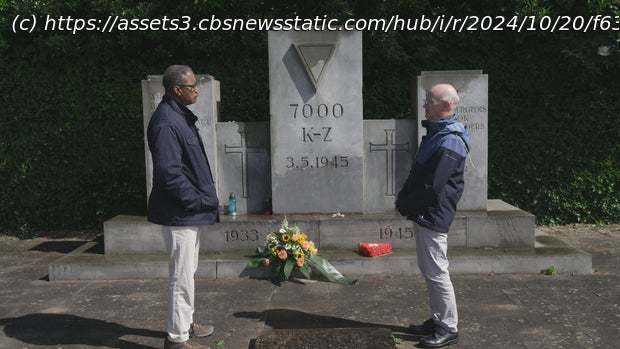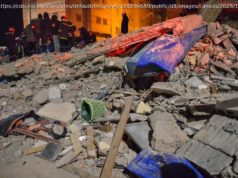The Cap Arcona, a Nazi ship, was attacked by British Royal Air Force planes near the end of World War II. Thousands of prisoners died as the ship sank in the horrific and little-known disaster.
This is an updated version of a story first published on Oct. 20, 2024. The original video can be viewed here.
Everyone knows the story of the Titanic, the opulent British ocean liner that struck an iceberg and sank. But it’s likely you have never heard of the Cap Arcona, a German version of the Titanic. Before World War II, the vessel was a cruise ship for the well-to-do. By the end of the war, the Nazis had transformed it into a floating concentration camp. Packed with prisoners, the Cap Arcona was anchored in Lübeck Bay in the Baltic Sea when an aerial attack just hours before liberation killed nearly everyone on board. As we first reported in October, the ship’s improbable journey from luxury liner to death trap is one of the most horrific and little-known war stories we have encountered.
On sunlit days, Germany’s Baltic coast looks idyllic. But this beauty masks an unthinkable horror, one that’s etched in the local memory and on this beachside marker bearing the name Cap Arcona and the German words for fear, panic, and grief.
Bill Niven: It’s so calm, so peaceful. And yet out there is a graveyard. You can come to a place like this and just feel the weight of the history.
British historian Bill Niven has spent much of his career studying the Holocaust. We met him at Lübeck Bay, where the memory of the Cap Arcona and a smaller cargo ship bombed on May 3rd, 1945 … still haunts this shore.
Bill Whitaker: What is this place?
Bill Niven: This is a memorial— an honorary memorial to the victims of the two ships that went down, with a loss of some 7,000 lives.
Bill Niven: It recalls all the nationalities that were victims of the sinking of the ships.
Bill Whitaker: There were Americans on the ships?
Bill Niven: Yes. There were Greeks, there were Italians, and the Jewish people of course, represented here by the Star of David.
Most of the victims were on the Cap Arcona. Every year on the anniversary of the attack, a somber ceremony is held at this site to remember those who perished … and those who suffered.
Bruno Neurath-Wilson: My father was one of the survivors of the sinking of the Cap Arcona.
Bruno Neurath-Wilson came to honor his father, Willi, a political prisoner held on the Cap Arcona. Only about 400 prisoners survived the attack, including Bruno’s father.
Bill Whitaker: What’s it like for you to be in this place?
Bruno Neurath-Wilson: When we go to the place where the Cap Arcona sank, I try to imagine what happened. I really cannot imagine what happened on the ship.
No one could have imagined this end for the Cap Arcona. Launched with great fanfare in 1927, the ship became known as the «Queen of the Atlantic», transporting well-heeled passengers from Europe to South America in two weeks.
Bill Whitaker: What was it like in its heyday?
Bill Niven: Well, it was one of the most beautiful ships the Germans had. It had its own tennis court. It had a heating swimming pool. It had the most wonderful restaurant where you could look out onto the sea. The most wonderful first-class cabins.
Bill Whitaker: It was a luxury– a luxury cruise ship?
Bill Niven: It was a luxury, luxury cruise liner. Absolutely was.
The Cap Arcona traversed the Atlantic dozens of times. But in 1933, Germany underwent a sea change.
Adolf Hitler came to power.
In 1939, as German troops invaded Poland, the Nazis commandeered the Cap Arcona to serve as a floating barracks in the Baltic. Ironically, on one of its last trips before the war, the ocean liner carried some German Jewish passengers who had bought tickets to safety in South America. But most Jews had no way to escape.
Manfred Goldberg: We were rounded up and sent to the concentration camp, just the three of us, my mother, I, and my younger brother.
95-year-old Manfred Goldberg was just 11 when the Nazis forcibly removed him and other Jews from his hometown of Kassel in central Germany.
Manfred Goldberg: The cruel experiences during my young years between 11 and 15, they’re firmly lodged clearly in my mind to this day.
He would survive confinement in the Riga, Latvia ghetto and four different concentration camps.
Manfred Goldberg: We lost our names. Each one of us was given a number instead. In th— the well-know camp of Auschwitz, people had their number tattooed on their arm. But we had to remember our numbers. My number incidentally was— 56478. If you forgot it in the camps, you were usually punished for it. So I buried it in my mind so as never to forget it. And I won’t, as long as I live.
In Nazi-held Latvia, Goldberg, his mother Rosa and other prisoners were forced to repair bombed out railroad tracks during the day. When they returned to camp one night, they learned the SS had taken Manfred’s little brother Hermann, and three other children. They were never seen again.
Manfred Goldberg: They just disappeared off the face of the Earth. The next morning, both my mother and I had to line up and go to work as though nothing untoward had happened.
Bill Whitaker: What did that do to you and your mother?
Manfred Goldberg: I had grown close to my brother because my mother packed some fairy tale books— stories f— for small children. And we would lie on the floor side by side, and I would read to him because he couldn’t read himself. As a result, we were s- very close to each other. So when he disappeared, I was nearly as heartbroken as my mother at the loss of her little baby, so to speak. He was seven when he went into the camps and nine the day he disappeared.
Goldberg and his mother ended up in the Stutthof camp in Nazi-occupied Poland. Another young boy, George Schwab, was imprisoned there, too.
George Schwab: The crematorium burning, you know, bodies all the time, gassing them. Terrible.
Schwab is 93, but he was only 9 when German soldiers invaded his hometown of Liepāja, Latvia. Schwab’s father, a prominent physician, tried to protect other Jews in town.
George Schwab: He noticed SS trucks were approaching, and he waved for fellow Jews to disperse and they arrested him, knocked out one eye, threw him down the cellar, and then killed him.
Bruno’s father, Willi Neurath, was not Jewish, but he actively opposed the Nazi regime.
Bruno Neurath-Wilson: My parents belonged to the small minority of German people who fighted against the Nazis. They didn’t fight with weapons, of course.
Bill Whitaker: Fight with their words?
Bruno Neurath-Wilson: Yes. Fighting with papers, with printed papers.
Willi was arrested for distributing anti-facist fliers.
Bruno Neurath-Wilson: They brought him to Buchenwald. And— from Buchenwald, they brought him to the concentration camp Neuengamme by Hamburg.
The Neuengamme work camp mostly held political prisoners. Inside this massive warehouse, historian Bill Niven told us prisoners like Willi Neurath made bricks.
Bill Whitaker: What does it feel like to walk in here?
Bill Niven: It feels like a factory of death. You can sense what went on in this place.
Bill Whitaker: But this was not a death camp, this was a work camp.
Bill Niven: It’s a very, very slim distinction. In the course of this work, they die. They die in droves.
Willi Neurath managed to survive but, as fate would have it, he, Schwab, the Goldbergs, and the Cap Arcona all would end up at Lübeck Bay, one of the last Nazi defensive positions.
In 1945, as the Allies were closing in, the Cap Arcona – now rusted and battered – was repositioned to Lübeck Bay. At the same time, SS Chief Heinrich Himmler ordered the evacuation of concentration camps.
Домой
United States
USA — Events Families of Cap Arcona victims want world to remember Nazi ship sunk...






